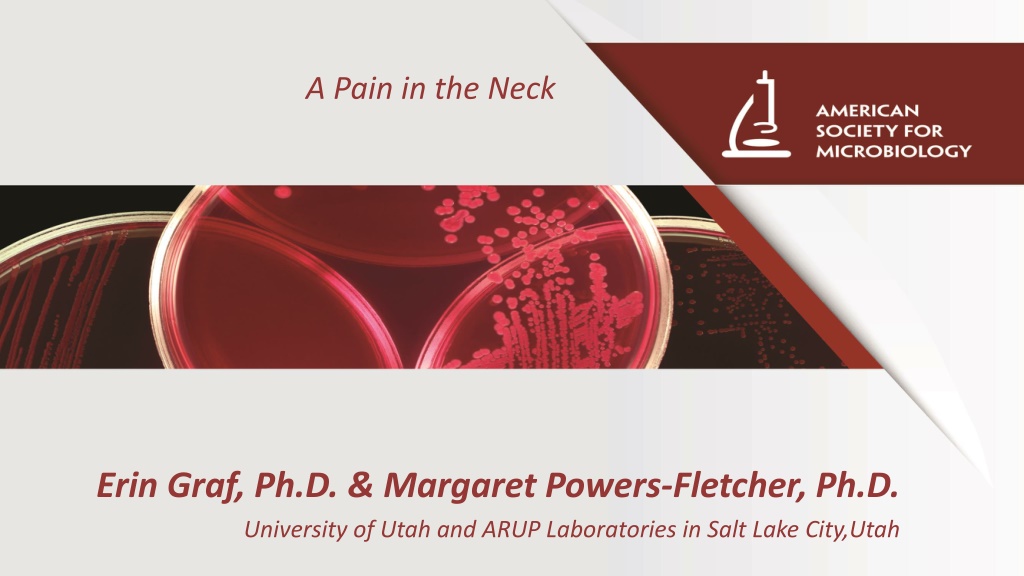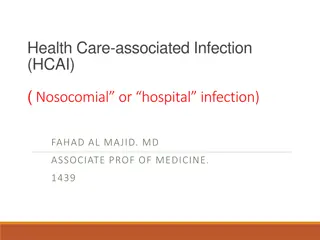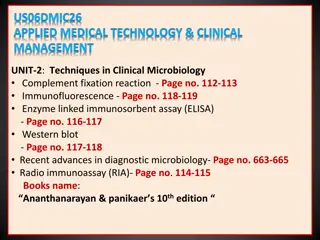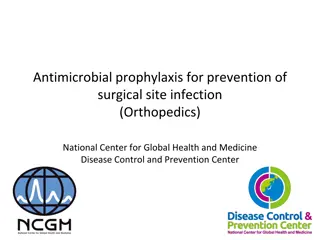Understanding Anaerobic Infections: A Case Study in Clinical Microbiology
In this case study, two patients present with fever, neck pain, and previous misdiagnoses of viral pharyngitis. Blood cultures reveal anaerobic growth, with Gram stain showing pleomorphic Gram-negative rods. Anaerobic cultures require specialized conditions for growth, such as anaerobic glove box incubators. Various types of agar and broth media aid in the recovery of anaerobes for proper identification and treatment.
Download Presentation

Please find below an Image/Link to download the presentation.
The content on the website is provided AS IS for your information and personal use only. It may not be sold, licensed, or shared on other websites without obtaining consent from the author. Download presentation by click this link. If you encounter any issues during the download, it is possible that the publisher has removed the file from their server.
E N D
Presentation Transcript
A Pain in the Neck Erin Graf, Ph.D. & Margaret Powers-Fletcher, Ph.D. University of Utah and ARUP Laboratories in Salt Lake City,Utah
Case 1 Case 2 A 16-year old male presents to the Emergency Department with a fever of 104 F, neck pain and right sided chest pain. 3 days prior he was seen at an urgent care clinic for sore throat and fever. A rapid Group A Streptococcus (GAS) test was performed and was negative. He was sent home with a diagnosis of viral pharyngitis. A 23-year old female presents to the Emergency Department with a fever of 102.4 F, sore throat, neck pain and right hip pain. 3 and 5 days prior she was seen in the Emergency Department. No microbiology testing was ordered. Both times she was sent home with a diagnosis of viral pharyngitis.
Case 1 Case 2 An X-ray of his chest is performed. Shows multiple nodules in both lungs: concern for infection Blood cultures are ordered. A Computed Tomography (CT) scan of her pelvis is performed. Shows gas around the hip joint and thickening of thigh muscle: concern for infection. Blood cultures are ordered. Culture of tissue from her right hip is also ordered.
Laboratory Testing The anaerobic blood culture bottle from both patients becomes positive. See case study Of Mice and Men for description of blood cultures. A Gram stain of the bottle for each patient performed (see next slide). The blood culture bottle is sub-cultured onto anaerobic agar media and placed in the anerobic chamber for incubation.
Blood Culture Bottle Gram Stain Reported as Pleomorphic Gram negative rods Photo Credit: Erin Graf, Ph.D. & Margaret Powers-Fletcher, Ph.D.
Anaerobic Culture Conditions Obligate anaerobes require special incubation conditions as even small amounts of oxygen can be toxic to growth. An anaerobic glove box incubator can be used for these types of cultures. The incubator pumps in an anaerobic gas mixture (mostly nitrogen with a small amount of CO2 and H2) and contains a catalyst within the incubator space that absorbs O2. Smaller laboratories may use air tight boxes or anaerobic jars with catalyst pouches that absorb O2.
Anaerobic Glove Box Incubator Photo Credit: Erin Graf, Ph.D. & Margaret Powers-Fletcher, Ph.D.
Anaerobic Culture Media Four different types of agar and a broth to enhance recovery of anaerobes were inoculated. The media is described as follows: Brucella Blood Agar - Non-selective media, most anaerobes will grow. PEA (Phenylethyl Alcohol) Selective media for Gram positive anaerobes. LKV (Laked blood+ Kanamycin+Vancomycin) - Facilitates growth of Prevotella and Bacteroides sp. BBE (Bacteroides Bile Esculin) - Selective for Bacteroides fragilis group. Only strict aerobes are identified further. Aerotolerance of isolates must be tested by subculture and incubation in aerobic conditions.
Blood Bottle Subculture From Patients 1&2 (After 48 Hours In Anaerobe Chamber) Brucella Blood Agar (failed aerotolerance test). No growth on PEA. No growth on aerobic subculture Split plate of LKV on left and BBE on right Photo Credit: Erin Graf, Ph.D. & Margaret Powers-Fletcher, Ph.D.
Microbiology Laboratory Results Patient 1&2 s blood cultures (and the hip tissue from patient 2) grew a single anaerobic bacteria identified as: Fusobacterium necrophorum
Fusobacterium necrophorum Common flora of the mouth. Opportunistic pathogen. Associated with dental infections, sore throat and peri-tonsillar abscesses. The most severe association is internal jugular vein thrombosis leading to bacteremia and dissemination of septic emboli, otherwise known as Lemierre s syndrome .
Lemierres Syndrome Case series published by Andrew Lemierre in 1936. Described throat infections followed by sepsis with high mortality rate (before antibiotics). It is a rare disease, but recent studies suggest incidence may be rising1, 2. Patients usually present with sore throat that progresses to neck pain and often visit the ED multiple times without a diagnosis because there is so much overlap with more common infections such as viral pharyngitis or Strep throat. The clinical microbiology laboratory is instrumental as a blood culture identification of F. necrophorum guides diagnosis and follow up. 1 Brazier JS et al. J Med Micro 2002 2 Ramirez S. et al. Pediatrics 2003
Patient Outcomes Both patients were diagnosed with Lemierre s Syndrome after blood culture identification of F. necrophorum. Patient 1 received the intravenous antibiotic Piperacillin/tazobactam (Zosyn) and recovered quickly. Patient 2 received IV Ampicillin/Sulbactam (Unasyn) and had a more complicated course requiring multiple debridements of her infected right hip.
Erin Graf, Ph.D. Margaret Powers-Fletcher, Ph.D. Dr. Powers-Fletcher is a first year CPEP fellow at the University of Utah and ARUP Laboratories in Salt Lake City, UT. She obtained her Ph.D. in Pathobiology and Molecular Medicine from the University of Cincinnati College of Medicine. Her thesis work focused on stress response pathways of the opportunistic fungal pathogen, Aspergillus fumigatus. She has expanded on her interest in medical mycology during her fellowship, working on advanced fungal diagnostics and susceptibility testing. Dr. Graf is a second year CPEP fellow at the University of Utah and ARUP Laboratories in Salt Lake City, Utah. Upon completion of her fellowship, Dr. Graf will become Assistant Director of Clinical Microbiology and Virology at the Children s Hospital of Philadelphia. Her research interests include adaptation of next generation sequencing technologies and metagenomics for diagnosis in the clinical microbiology laboratory. Photo Credit: Erin Graf, Ph.D. & Margaret Powers-Fletcher, Ph.D.























